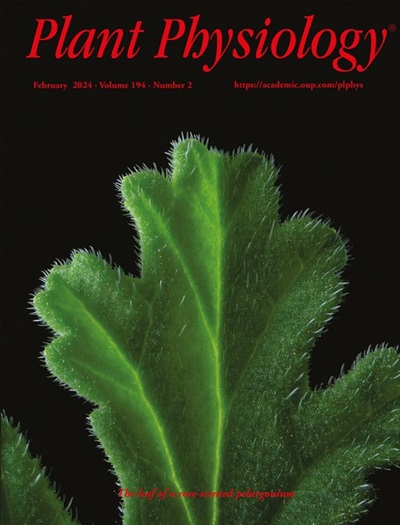植物色素 B 促进水稻抗稻瘟病和增产。
IF 6.5
1区 生物学
Q1 PLANT SCIENCES
引用次数: 0
摘要
植物色素是一种红/远红光受体,可调节植物生长、发育和胁迫反应的各个方面。植物色素 B(PhyB)介导的光信号影响植物防御和发育的确切机制仍不清楚。本研究表明,与野生型植物相比,PhyB 能增强水稻(Oryza sativa)的抗稻瘟病能力、分蘖能力和粒径。值得注意的是,PhyB 与分蘖发育的负调控因子--禾本科分蘖 1(GT1)相互作用并降解。在phyB背景下敲除GT1可部分缓解phyB分蘖减少的问题。然而,GT1 对水稻抗稻瘟病具有负调控作用,这表明 PhyB 对 GT1 的降解促进了分蘖,但并没有促进抗稻瘟病。之前发现 PhyB 与植物色素互作因子 15(PIL15)相互作用并降解 PIL15,PIL15 是种子发育的关键调控因子,可降低水稻的抗瘟性和种子大小。PIL15 在 phyB 突变体中的突变可挽救 phyB 的种子大小和抗瘟性,这表明 PhyB 可能与 PIL15 相互作用并降解 PIL15,从而负向调控抗瘟性和种子大小。与野生型相比,sweet2a 突变体对稻瘟病的敏感性更低。总之,这些数据表明 PhyB 通过抑制转录因子 GT1 和 PIL15 以及下游信号转导来提高水稻产量和抗稻瘟病能力。本文章由计算机程序翻译,如有差异,请以英文原文为准。
Phytochrome B promotes blast disease resistance and enhances yield in rice.
Phytochromes are red/far-red light receptors that regulate various aspects of plant growth, development and stress responses. The precise mechanism by which Phytochrome B (PhyB)-mediated light signaling influences plant defense and development remains unclear. In this study, we showed that PhyB enhances rice (Oryza sativa) blast disease resistance, tillering, and grain size compared to wild-type plants. Notably, PhyB interacted with and degraded grassy tiller 1 (GT1), a negative regulator of tiller development. Knockdown of GT1 in a phyB background partially rescued the diminished tillering of phyB. However, GT1 negatively regulates rice resistance to blast, suggesting that PhyB degradation of GT1 promotes tillering but not blast resistance. Previously, PhyB was found to interact with and degrade phytochrome-interacting factor 15 (PIL15), a key regulator of seed development that reduces rice resistance to blast and seed size. pil15 mutation in phyB mutants rescued phyB seed size and blast resistance, suggesting that PhyB might interact with and degrade PIL15 to negatively regulate blast resistance and seed size. PIL15 directly activated sugar will be eventually exported transporter 2a (SWEET2a). sweet2a mutants were less susceptible to blast disease compared to wild type. Collectively, these data demonstrate that PhyB promotes rice yield and blast resistance by inhibiting the transcription factors GT1 and PIL15 and downstream signaling.
求助全文
通过发布文献求助,成功后即可免费获取论文全文。
去求助
来源期刊

Plant Physiology
生物-植物科学
CiteScore
12.20
自引率
5.40%
发文量
535
审稿时长
2.3 months
期刊介绍:
Plant Physiology® is a distinguished and highly respected journal with a rich history dating back to its establishment in 1926. It stands as a leading international publication in the field of plant biology, covering a comprehensive range of topics from the molecular and structural aspects of plant life to systems biology and ecophysiology. Recognized as the most highly cited journal in plant sciences, Plant Physiology® is a testament to its commitment to excellence and the dissemination of groundbreaking research.
As the official publication of the American Society of Plant Biologists, Plant Physiology® upholds rigorous peer-review standards, ensuring that the scientific community receives the highest quality research. The journal releases 12 issues annually, providing a steady stream of new findings and insights to its readership.
 求助内容:
求助内容: 应助结果提醒方式:
应助结果提醒方式:


